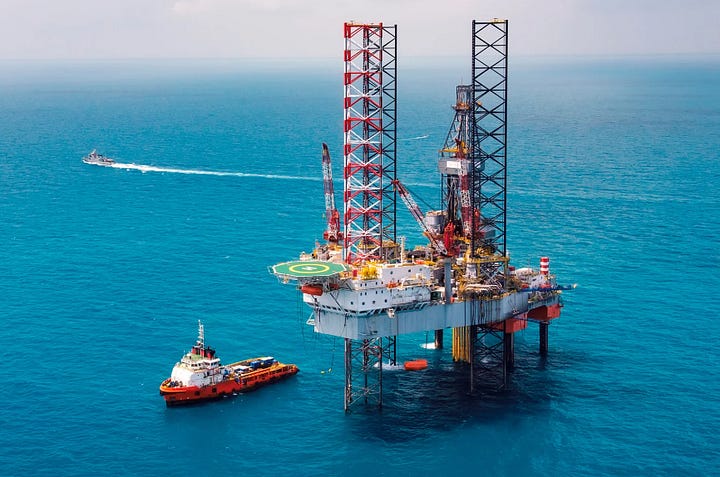The Colorfully Opaque World of Plastics (Part 1)
...and we need to trudge through some oil and gas to get there
When you become a parent, all sorts of new questions pop into your head: What are we feeding the kids? How is their development going? What type of school should we enroll them in? How much should we save for college? But if you’re like me, you also ask: Where the hell are all these plastic toys we’re buying them made? What are they made out of? Are they safe? And where on earth do they go if (and inevitably, when) we throw them away?! A landfill? The ocean? Do they leach stuff into our bodies?
I was Christmas shopping last month for my two boys and stopped at a massive toy store the likes of which I hadn’t seen since Toys "R" Us. It brought back memories. As I walked through the aisles, I couldn’t help but notice the complexity of modern toys—all sorts of plastic parts in different shapes, colors, and textures. And I just stood there for a moment in awe, thinking: Who makes all of this? How is it made? Where is it made? For a thing so ubiquitous and essential to everyday life — plastic — why do so few know or think about it? I needed to know more — and now I do — so let’s dive right in and explore this colorful yet simultaneously opaque world of plastics. By the way, here’s what I was just standing there staring at…


Isolating the building blocks of plastic from oil and gas
Virtually all of the world’s plastic is derived from certain chemicals or "feedstocks" which are extracted from crude oil and natural gas—like ethane (which is "cracked" to become ethylene, which is "polymerized" to become polyethylene) or propane (→ propylene → polypropylene). Polyethylene (PE) and polypropylene (PP) make up about half of the world’s plastic products, but the remaining half is made up of dozens of other types of plastics of various chemical compositions. But in almost all cases, plastics are derived from chemicals pulled from under the ground. Those that aren’t are derived from renewable sources like corn, sugarcane, or cellulose, but these bioplastics only make up about 1% of global plastic production and are much more expensive to manufacture than those derived from oil or gas.


I’d imagine for many people, the mention of “crude oil” or “natural gas” elicits images of some black sludgy liquid or brown gas —dirty pipes, dangerous wells, offshore rigs— and thoughts of dead dinosaurs or ancient plants compressed over millions of years that we just pump out of the ground—hence “fossil fuels.” If they took chemistry in high school and were paying attention, then maybe they know they contain “hydrocarbons”—links of chemically bonded hydrogen and carbon atoms like in methane (CH₄) - lightest molecular weight, ethane (C₂H₆) - heavier, propane (C₃H₈) - even heavier, butane (C₄H₁₀) - heavier still. Then there’s pentane (C₅H₁₂) and hexane (C₆H₁₄) and several others which are heavier. These “-anes” are called alkanes.
Natural gas is just a blend of the lightest hydrocarbons, beginning with methane (pure natural gas) which is primarily used as a fuel source because it can’t be cracked and polymerized into plastics — processes we’ll dive into shortly. The next heaviest — ethane, propane, and butane — are actually called natural gas liquids (NGLs) because they’re in liquid form until extracted to the surface. (e.g. think of how how soda is liquid under pressure but releases some gas when you open the bottle).
Crude oil is similarly a complicated mixture, but it contains a wide range of hydrocarbons. One of its distilled fractions, naphtha, consists of lighter alkanes (like hexane and heptane), cycloalkanes (like cyclohexane and cyclopentane), and aromatics (like benzene and toluene)— we’ll discuss naphtha shortly. Crude can can appear as a dark, viscous oil but can also be a light white or yellowish fluid. It all depends on its chemical composition, density, and sulfur content—which in turn is influenced by the pressure and temperatures the geological formation was exposed to, the duration of that exposure, and whether bacterial activity played a role in breaking down hydrocarbons.
Oil and, to a lesser extent, NGLs can also contain small amounts of impurities such as salts, water, nitrogen, sulfur, and metals that need to be extracted before processing or refining. If not removed, these impurities can damage processing equipment or lead to the production of unwanted byproducts. The level of impurities vary depending on the geographical source of the oil or gas. For example, heavy crude oils found in regions like Venezuela’s Orinoco Belt (one of the largest oil deposits in the world) and Canada’s oil sands often contain more sulfur and metals due to lower geological pressure and temperature during formation — meaning these chemicals have been slow break down. In contrast, ultra-light crudes and natural gas liquids (NGLs) found in the Middle East and the United States (especially from shale formations like the Permian Basin, Eagle Ford, and Bakken Shale) are generally lower in density and contain fewer impurities because they were exposed to higher temperatures and pressures over time — breaking them down faster. The point is that refining these resources involves an unbelievably complex series of steps, which is precisely what occurs at oil refineries and natural gas processing plants—those labyrinthian networks of pipes and towers you see while driving down the New Jersey Turnpike, near Houston, Texas, or in the refinery hubs of Louisiana and California — like these…


